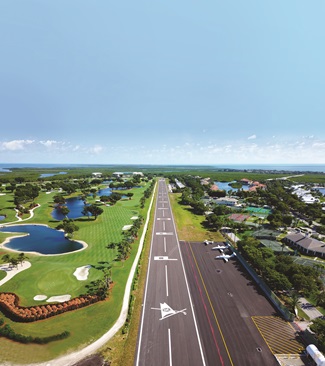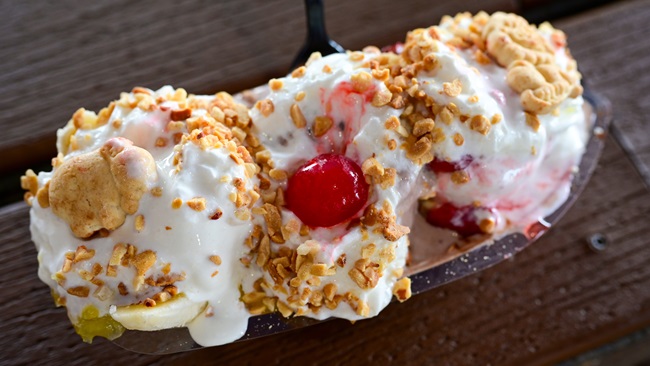PIC to the Bahamas
Getting there is half the fun
Once you’ve flown a general aviation airplane to the Bahamas, you start counting down the days until you can return.
In my case, it was close to five years. I’d first joined a group of pilots doing a group fly-out to the Out Islands in 2014. We flew from Virginia to Fort Pierce, Florida, to Cat Island, part of the Out Islands or “family islands” chain. I was a backseat passenger for most of that trip. I got some left-seat time in a Piper Seminole—that was a thrill in itself—but I never lost the desire to take the reins and fly myself back to the white sandy beaches and turquoise ocean water.
It finally all came together in December 2018. A few months before, a friend who frequently organizes casual flying trips to the Bahamas put out a call on Facebook for one that aligned with my schedule. I signed up, booked one of the rooms she had arranged through the Viva Wyndham Fortuna Beach in Freeport, started praying for good VFR weather, and made sure I had all the necessary documents for airplane and pilot to make the trip.
Quick stop in Georgia
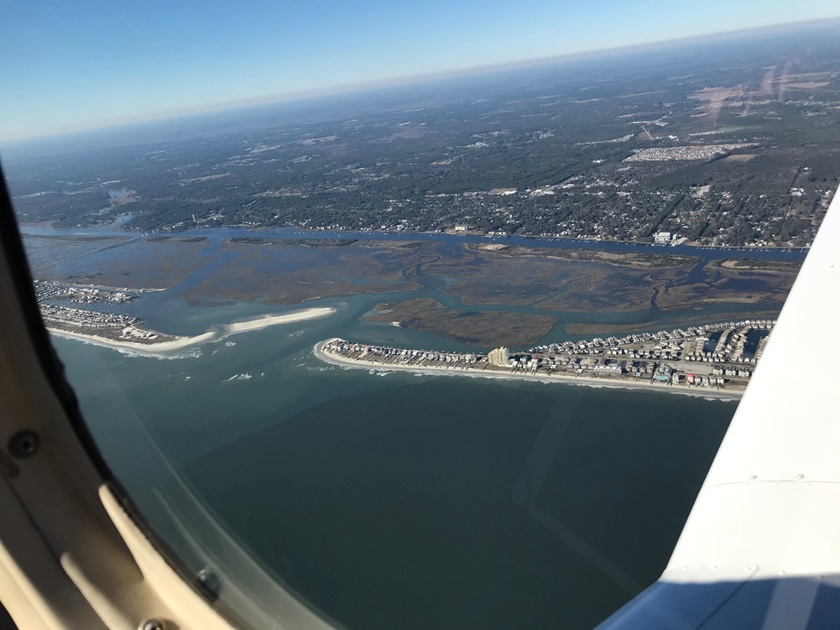
Members of the group planned to launch from various airports in Florida. I flew my Piper Cherokee 140 down the East Coast from Maryland to Fort Lauderdale, where we would stage before launching for Freeport. Maryland to Florida is about nine hours in my airplane with its 160-horsepower Lycoming, so I broke the trip up over two days. I’d asked pilot Lisa Wood to join me on the trip. We slipped down the coast at a leisurely 110 knots, taking numerous photos of the Atlantic Ocean. You can never have enough “wing view Wednesday” photos.
We overnighted at McKinnon-St. Simons Island Airport on the coast of Georgia, which turned out to be a fantastic stopover choice. Golden Isles Aviation line staff exemplified Southern hospitality by rolling up with a golf cart as we taxied in to tote us and our bags to the front desk. A Home 2 Suites by Hilton is steps from the front entrance of the fixed-base operator—go outside, turn right, walk inside. Our room looked out onto the ramp, so Lisa and I could keep an eye on my airplane and watch some larger aircraft hustling in and out.
When the Golden Isles front desk folks asked what type of dinner we were looking for—“seafood or BBQ?”—we didn’t hesitate. Fresh seafood would be plentiful in Florida and the Bahamas, but I never turn down barbecue if I can help it. A few blocks’ walk from the hotel took us to Southern Soul Barbeque, a bustling place housed in a converted 1940s gas station. It was tough to choose from among ribs, Brunswick stew, and house-smoked sausage, but in the end we both ate way too much smoked pork barbecue, and I didn’t regret one mouthful.
On to Florida
The next morning’s leg from St. Simons to Fort Lauderdale was exciting. I’d been receiving VFR traffic advisories for the entire trip—especially comforting in areas where special-use airspace is abundant. As we made our way toward Daytona Beach, the airwaves were crackling with conversations between air traffic control and Embry-Riddle Aeronautical University students, identifiable by their “Riddle” call signs.
The volume of traffic displayed via ForeFlight on my iPad was disconcerting. I won’t say we didn’t heave sighs of relief when we landed at Fort Lauderdale and taxied over to Banyan Air Service.
To paraphrase the airlines, you have a choice in airports when departing the United States for the Bahamas. (You can depart from any of them; but you must land at an airport of entry.) I chose Fort Lauderdale Executive Airport because Banyan has a reputation as an FBO that knows all about Bahamas travel—not to mention excellent customer service.
At shutdown a Banyan lineman was waiting with a golf cart and bottles of water. (Even though it was a chilly 60 degrees in Fort Lauderdale, that water was greatly appreciated.) From there, Banyan representatives checked us in, scheduled us for fuel service, and presented us each with a pair of souvenir sunglasses. At the same counter, I rented a life raft. At $35 per day, I considered this cheap insurance in the event of having to ditch in the ocean (I had borrowed the required life vests from another pilot).
We also walked a few hundred yards to visit Banyan’s extensive—and I do mean extensive—pilot shop. Want to buy a Miami sectional? They’ve got it. Want to outfit your airplane’s panel with some new Garmin goodies? They’ll sell those to you and install them right there. Three HondaJets—one red, one green, and one blue—were parked in the adjoining hangar. Banyan wears a lot of hats, and one of them is HondaJet dealer.
Ready for the Bahamas
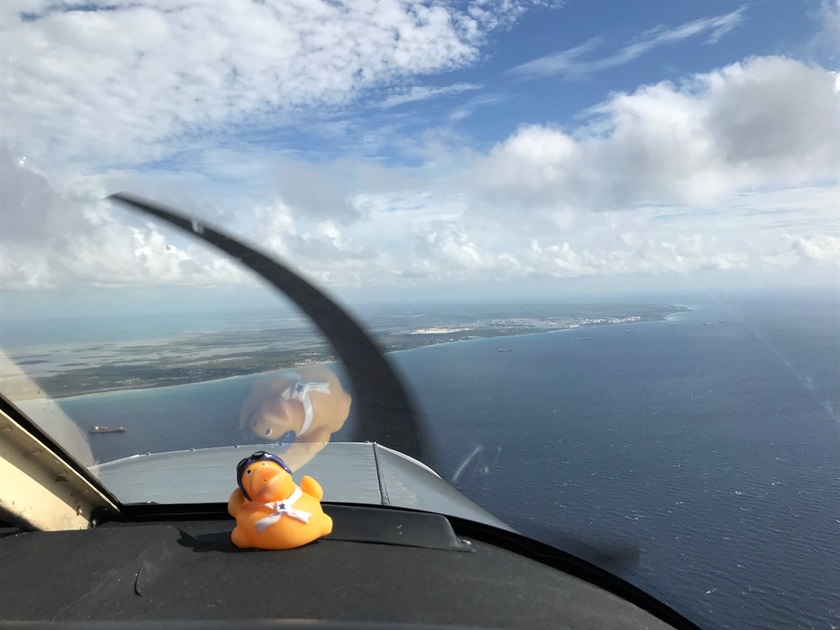
The morning of our departure, some of the pilots traveling in the group—about 15 airplanes total—got to know each other a bit as we were preflighting, putting on our life jackets, and loading our baggage alongside each other’s airplanes. Corbi Bulluck had flown her Piper Dakota from North Carolina. She showed me how she had filed an international (D-VFR) flight plan on ForeFlight. I had called Lockheed Martin to file mine and had received the required squawk code from the briefer. The eAPIS notice of departure had been filed before I left for Florida—one less thing to worry about.
We took off, and between opening a flight plan and requesting flight following from Miami Center, I was busy. I barely had time to listen for suspicious engine noises when it seemed as though Grand Bahama Island loomed on the horizon. The runway at Grand Bahama International Airport is easy to spot, and at 11,018 feet long, it can handle most any air traffic.
There’s ample general aviation parking, but tiedowns seem to be a haphazard arrangement of cables and … nothing, so it’s best if you bring your own. Sunny Bahamian smiles and warm welcomes from the staff at Grand Bahama Airport Co. reminded me why I’d wanted to return so much. The FBO sells avgas as well as jet A, and the airport has a Customs office, so if you’re not planning to stay at Freeport but you need to get fuel, you can land here, clear Customs, fuel up, and be on your way. While Bahamas Customs now accepts credit cards for some of the fees, it’s wise to bring cash. The Bahamas accepts U.S. dollars on a one-for-one basis.
A $5 cab ride took us to the Viva Wyndham, an all-inclusive resort. With snorkeling, scuba diving, poolside activities like dance lessons, and nightly entertainment, the Wyndham is like a cruise ship that doesn’t go anywhere. You can purchase excursion packages for horseback riding, sailing, and other activities at additional cost.
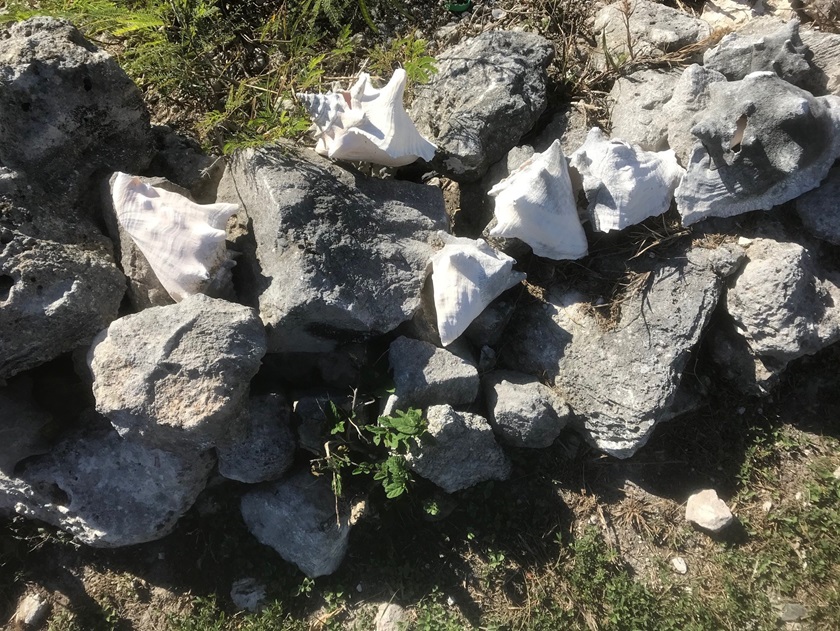
We set aside one day for some island hopping. A Form C7a cruising permit allowed us to do just that, taking off from Grand Bahama International Airport to fly about 70 nautical miles to Great Harbor Cay Airport in the Berry Islands. While waiting for a cab, we watched an RV–8 owner land and chatted with him. The Beach Club restaurant adjacent the airport was said to have a fantastic hamburger, but the restaurant was closed on the Monday we arrived. Instead we ate chicken and rice at Coolie Mae’s Sunset Restaurant, perched on a bluff ringed with conch shells overlooking the ocean. The spicy food and fantastic views were alluring, but we had to make sure we were on the ground back at Freeport before sunset, as the only night flying permitted in the islands is on an IFR flight plan to one of two towered airports in the entire chain of islands.
Back to the US
We’d barely had a chance to get our feet wet in the Atlantic, it seemed, before it was time to head back to the United States. Similar to what was required to depart the United States, I filed an eAPIS manifest and notice of arrival, then filed a flight plan and activated it in the air and received a squawk code to re-enter the United States. At Freeport, I also submitted a paper flight plan form to the Bahamas Department of Civil Aviation.
Pilots returning to the United States are required to call U.S. Customs and Border Protection at their arrival airport to receive approval for landing. This call created the only hiccup of our trip—the number we had been provided for Fort Lauderdale went directly into someone’s voicemail. We contacted Miami CBP for an alternate phone number, and soon we were on our way.
Landing at Fort Lauderdale, we taxied directly to the CBP office, unloaded the airplane, and waited only a short time to be processed. I’d thought about hurrying up the coast to St. Simons that same day, but gathering clouds along the route prompted me to spend another day in Florida. I wasn’t in any hurry to leave behind the warm weather and sunshine from my jaunt to the Bahamas.



